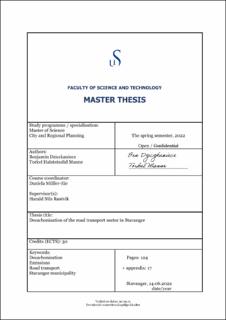| dc.description.abstract | The transportation sector is the second-largest contributor to greenhouse gas emissions by sector globally. In Stavanger, the transport sector is the primary contributor to greenhouse gas emissions. To decarbonise, the process of mitigation and reducing emissions, in 2010, the municipality adopted its own Climate and Environment Plan, which targeted a reduction of 20% by 2020 compared with 1991 emissions. In 2016, the Plan was effectively concluded, with the production of new targets from 2018. The targets were superseded, and no review of the document was undertaken following the conclusion of 2020. The current research seeks to address this.
The approach taken was to review the 2010 plan, identify the targets set and the policy approach taken. We then compared it with a similar plan, the Trondheim Energy and Climate Plan (2010 – 2020). Secondly, we investigated whether emission targets had been met and if there were other indicators to determine whether decarbonisation was being made relative to specific policies.
The significant findings of the research paper were that the 2010 plan adopted policies in line with the Avoid – Shift – Improve approach, which was also adopted within the Trondheim plan. Furthermore, the policies in the 2010 plan were primarily to encourage behaviours, through “carrot” policies, as opposed to restrictive policies or “stick”. When comparing with the Trondheim plan, it was evident that the Stavanger 2010 plan was less specific in terms of measures, targets identified and parties responsible for those measures.
In terms of the statistical data, we deduced that emission targets were not met, and they fell short of their goals. However, there was progress in terms of technological improvements, with a significant increase in low-emission cars. In the period 2009 - 2019, there was evidence of modal shift, with increasing passenger numbers on modes of public transport and a reduction in the use of cars. Before a reversal in 2020, the year of Covid-19, where public transport usage fell significantly and there was an increase in car usage. There was less evidence concerning reducing the need to travel. Further findings were that, despite the restrictive nature of the transport sector in 2020 as a result of Covid-19, the municipality still fell short of its emission targets.
Despite this, the targets for the new Climate and Environment Plan 2018-2030 are significantly higher, with a new goal of an 80% reduction in emissions. Based on historical data found over the course of the past ten years, they are likely to be significantly short of the target again. Further work is required to identify at a more detailed level where priorities need to be focussed for the municipality, but an overarching objective is that barriers need to be broken down to raise initiatives up the agenda. | |
